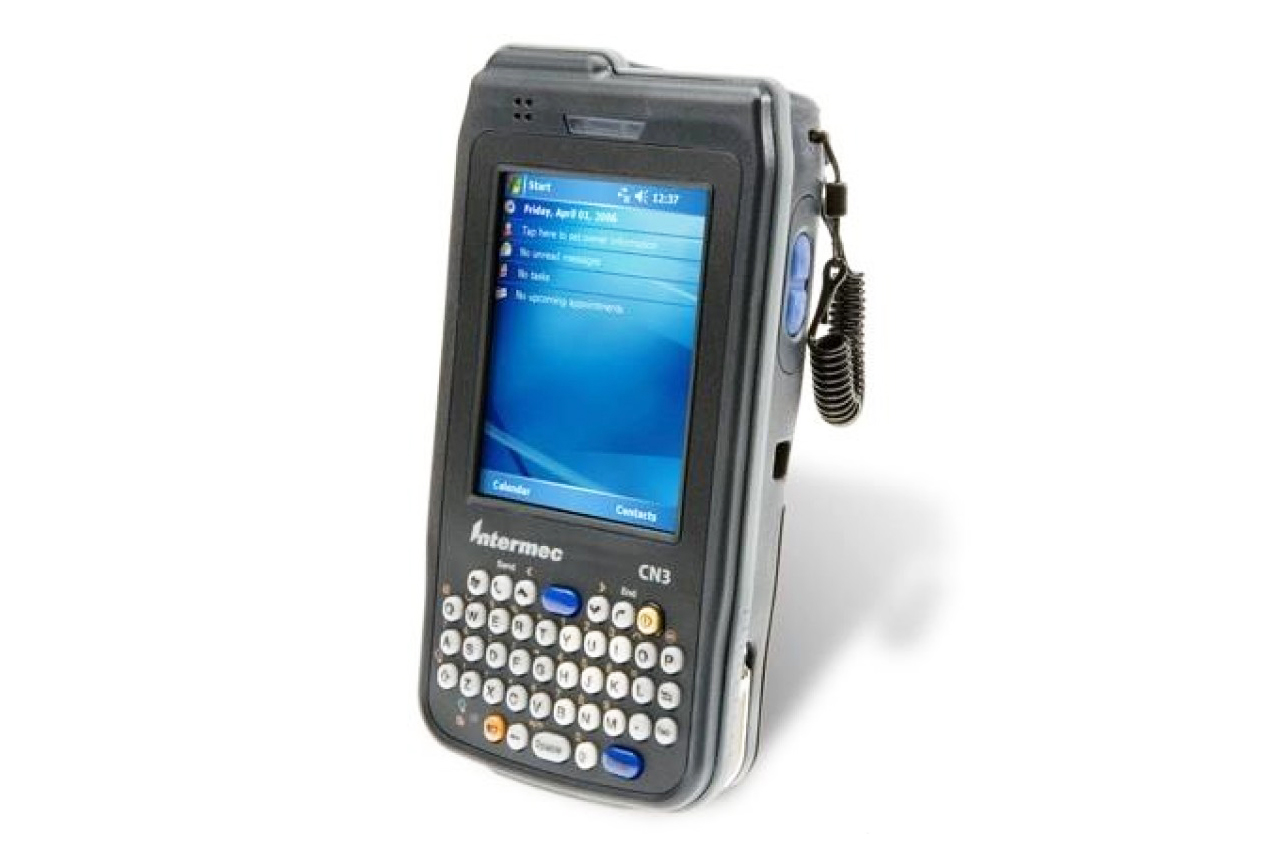Supercapacitors in handheld terminals
Handheld devices may require high power operations such as printing and wireless transmission. A supercapacitor supports a battery to for high peak power applications. CAP-XX’s low ESR, low profile prismatic supercapacitors can be easily integrated into any handheld device where size is critical, while our cylindrical cells offer a low-cost alternative if size is not crucial.
Supercapacitors provide both peak and backup power
Increasingly more industry sectors such as retail, manufacturing and agriculture are using handheld devices to track, organise and print data. To satisfy the many functions such as wireless transmissions, LED flash or scanning, and printing, devices need to maximise power whilst maintaining long battery run time all in a small package size for portability. Supercapacitors can benefit these devices through: pulse power support, extending battery life, support for low temperature operation, drop test and hot swap ability, “Last gasp” transmissions and graceful shutdown. The supercapacitor is an ideal power buffer, charged by the energy source at average load current and delivering periodic or sporadic bursts of peak current thus minimizing the load seen by the battery and the voltage droop seen by the load. This enables longer battery run time and operating capacity. The CAP-XX supercapacitor’s low ESR even at temperatures to -40°C enables terminal operation outdoors in the Northern winter.
If there is a temporary loss of power due to dropping the device causing battery contact chatter, the supercapacitor, with its high capacitance, can continue powering the system without any loss of data or need for a system restart. This prevents interruption of a transaction in a POS terminal.
APPLICATON BRIEF
AB1008 Rev 1.4
Supercapacitors in Handheld Terminals
Handheld devices in commercial and industrial applications must meet stringent performance requirements and may require many high-power operations such as LED flash and wireless transmission to run simultaneously. A supercapacitor effortlessly works with a battery to support large peak power applications. CAP-XX’s ultra-low-profile prismatic supercapacitors can be easily integrated into any handheld device where size is critical, while our cylindrical cells offer a low-cost alternative if size is not crucial.
POS, PDAs and Scanners
Increasingly more industry sectors such as retail, manufacturing and agriculture are using handheld devices to track, organise and print data. To satisfy the many functions such as wireless transmissions, LED flash or scanning, and printing, devices need to maximise power whilst maintaining long battery run time all in a small package size for portability.
Supercapacitors can benefit these devices through:
• Pulse power support
• Extending Battery life
• Support for low temperature operation
• Drop test and hot swap ability
• “Last gasp” transmissions
Supercapacitors complement batteries
The supercapacitor is an ideal power buffer, charged by the energy source at average load current and delivering periodic or sporadic bursts of peak current thus minimizing the load seen by the battery and the voltage droop seen by the load. This enables longer battery life and operating capacity.
For example, if a Class 10 GPRS module drawing 2A is supplied from a 3500mAh Li-ion battery with a GS230, the supercapacitor and battery will share load current as:
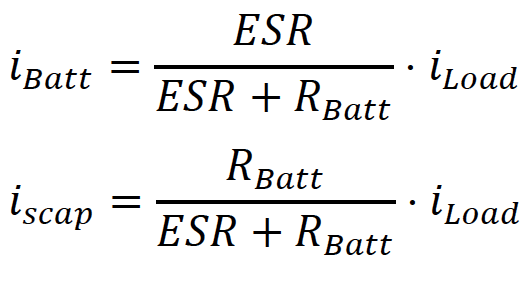
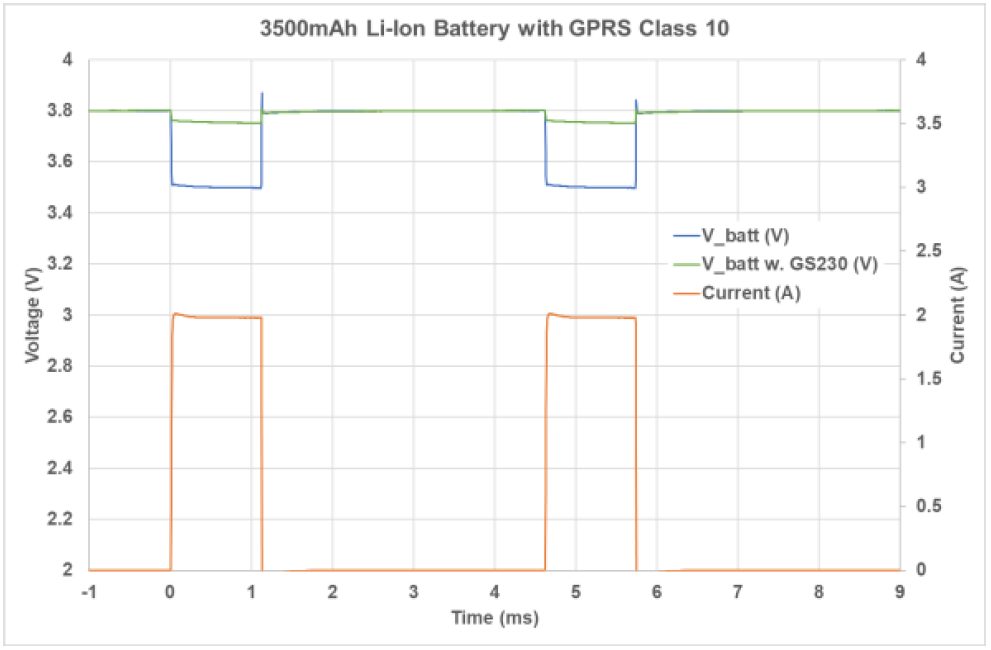
Due to the low ESR of the GS230 (1.2F, 25mΩ) compared to the Li-ion battery (150mΩ), there is only a ~45mV drop with the supercap compared to 300mV without as shown above. Also consider the DMF low ESR high power, DMT for long life high temp or DMH ultra thin series supercapacitors.
Not only does the reduced voltage drop allow for longer run time by preventing premature undervoltage lockouts but also introduces the potential to reduce size/weight/cost of the battery or use renewable or low power energy sources such as solar or vibration.
Furthermore, CAP-XX supercapacitors’ low ESR down to -40°C compared to batteries enables operation for sustained periods of time in low temperature environments.
Another key attribute of CAP-XX supercapacitors that make them ideal to place across a battery is their very low leakage current (IL), ~1µA/F. With only 1µA IL, plus ~700nA for a CAP-XX balancing circuit a GS230 only draws 15mAh/yr.
Supercapacitors provide power backup
Supercapacitors can also act as backup power source for battery hot swap with the use of a power select switch to put the unit in a low power mode.
If there is a temporary power loss due to dropping the device causing battery contact chatter, the supercapacitor can continue powering the system without any loss of data or need for a system restart, e.g. the figure above right shows a GW201 (0.4F, 55mΩ) using an LTC404 can support a system with continuous 100mA load until the battery is reconnected ~2 seconds later. If the unit was in a low power mode drawing 1mA, the supercap would allow 200s for a battery hot swap.
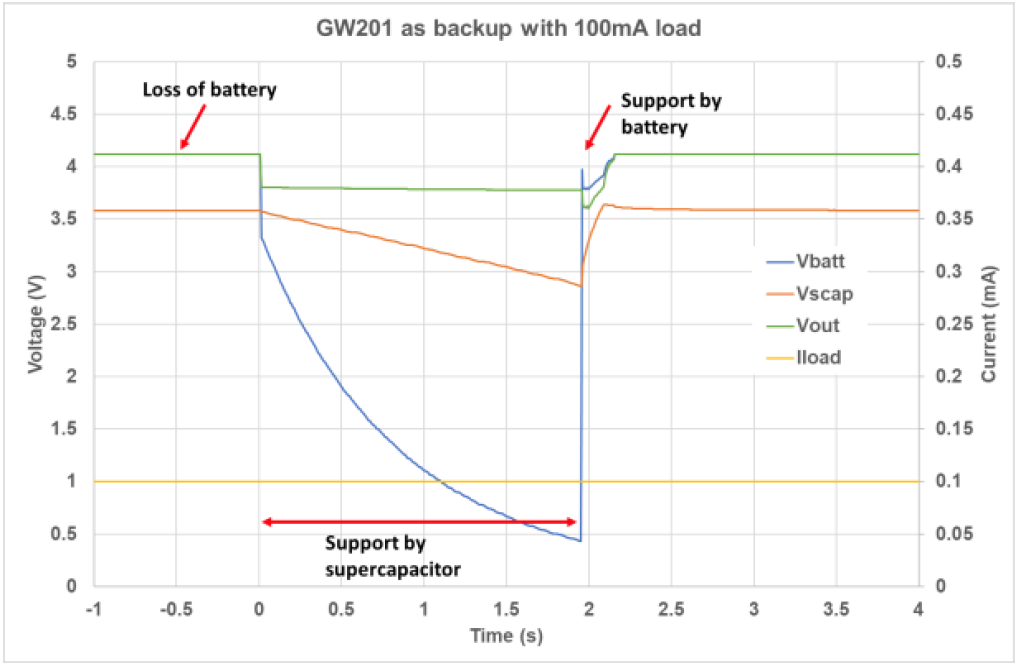
In the case of a permanent loss of power such as an ageing battery, depending on the size of the supercapacitor, the supercapacitor may be able to alert head office of an impending power loss (low battery charge) and/or complete final house-keeping functions before graceful shutdown without requiring the need for a separate backup battery. The figure below shows the GW201 can support the continuous 100mA load for more than 5 seconds before the system loses power.
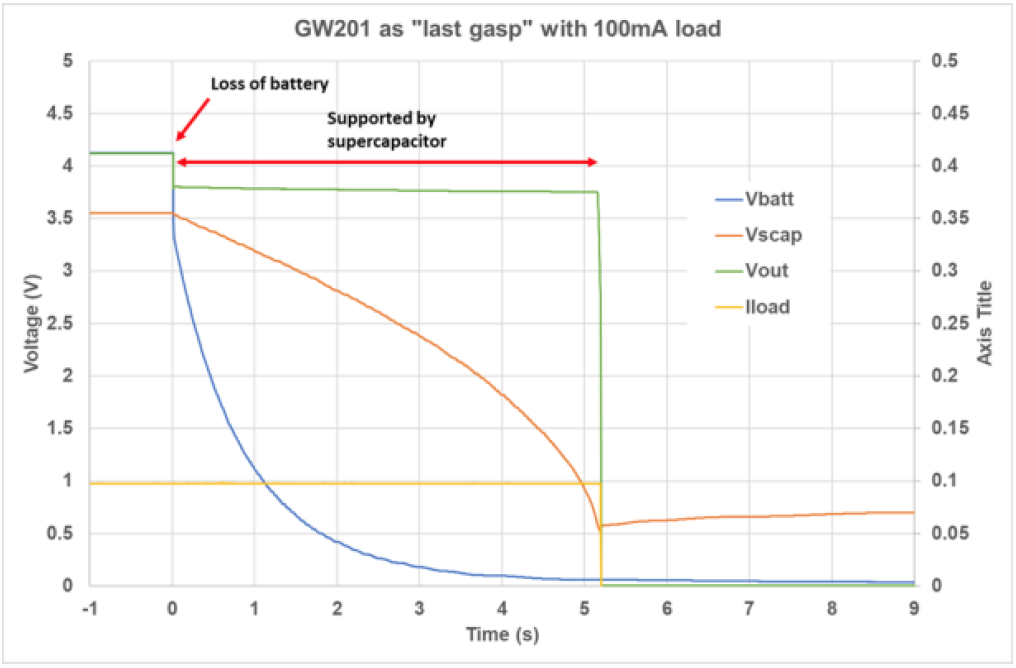
Sizing your supercapacitor
Sizing the supercapacitor to your application is essential to maximise operation according to your required voltage and energy, package size and life constraints. With CAP-XX’s large range of supercapacitors, from 0.09F to 2.4F in our prismatic range and 1F to 3000F in cylindrical cans, we are able to meet your application needs.
CAP-XX has a range of Application White Papers to assist customers’ design with supercapacitors. For more information please see Coupling a Supercapacitor with a Battery, Powering Pulse Loads and Use of a supercapacitor in a PDA.


